Η μεταπτυχιακή της διατριβή της Alice Pennacchioni έχει τίτλο:
RULES AND CHALLENGES OF FOOD LABELLING: A EUROPEAN LEGAL PERSPECTIVE
Ο στόχος μεταπτυχιακής διατριβής της Alice Pennacchioni επιτυγχάνεται απόλυτα. Η προσέγγισή της είναι σφαιρική και αφορά τόσο τις υποχρεωτικές, όσο και τα claims που μπορεί να εμφανίζονται στην συσκευασία ενός τροφίμου. Μπάινει δε και στην ουσία της επικοινωνίας του παραγωγού με τον καταναλωτή μέσω της ετικέτας. Εξαιρετική δουλειά!
Summary
As soon as the industrial innovations of the 20th century permitted the distance selling of foods, the provision of more accurate labels became a matter of primary concern, being the consumers interested in the adoption of conscious purchase choices and the producers willing to secure a trade based on fair commercial practices. The pre-existing inhomogeneous mechanism of communication of the food information was hence updated, combined and replaced by the Regulation (EU) 1169/2011, which empowered a constructive dialogue between the national and the EU levels, equally binding all the actors involved in the food chain to the respect of the new rules. Practically, the document increased the Member States’ cooperation, whose margin of intervention was drastically reduced, and promoted the overall market competitiveness, specifying a list of mandatory information to be integrated in the label. In order to maintain a certain degree of flexibility in respect of the evolving needs of the food sector, the Regulation was then internally articulated into different sections, where the first considers the provision of the food information, the second deals with the measures on food labelling and the last determines the range of action of such rules. The EU text of reference on the voluntary information is instead represented by the Regulation (EU) 1924/2006, adopted with the aim to harmonise the communicative tools used as a mean of attraction of the final consumer. In this respect, the EU legislators tried to uniform the presentation and advertising of the food products by setting up specific authorization procedures, requirements and restrictions for both the nutrition and the health claims. Moreover, they determined trustfulness requirements, evaluative criteria and equal parameters, necessary for implementing a strict control of the national measures and for clarifying the usable kind of signs. In addition, the legal document addressed the case of the so-called negative claims, namely «free-from» signs that highlight the absence rather than the presence of specific substances in the nutritional composition of a considered product. Nevertheless, with the aim to integrate their content on matters left uncovered at the EU level, the same Regulations invested the Member States with the competence to ratify national measures on food labelling. Διαβάστε το πλήρες άρθρο ΕΔΩ.
ΠΗΓΗ: academia.edu



 Ακολουθήστε το Cibum
Ακολουθήστε το Cibum 













